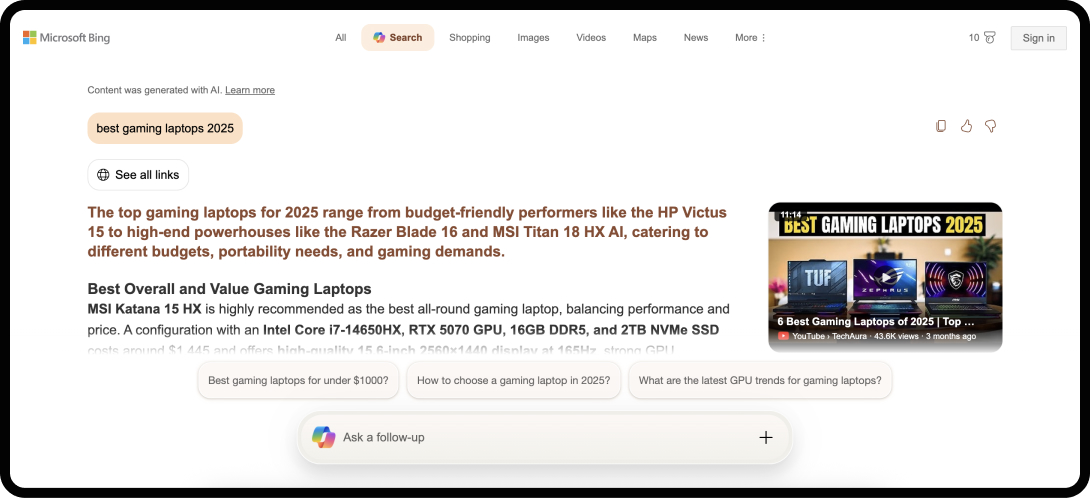You might have heard that the most popular query on Bing is “Google”. Still, don’t let this deter you from including Bing in your SEO efforts. Bing, developed by Microsoft, hit 100 million active users in 2023 due to its AI companion Copilot. Its integration with Microsoft Windows and Office further expands its reach, making it a vital platform for digital marketing.
The importance of Bing SEO in digital marketing cannot be overstated; with less competition than Google, businesses can find valuable opportunities to rank higher in search results.
Most importantly, though, Microsoft has a close relationship with OpenAI, and ChatGPT’s search index comes from Bing. Optimizing your content for Bing may give an increased competitive advantage by potentially boosting your chances of being cited in a synthesized answer by ChatGPT.
Let’s now delve into how to optimize for Bing specifically, and how your efforts may differ from optimizing for search kingpin Google. be attributed to the enhanced features and capabilities that the integration of AI brought to Bing, making it more competitive in the search market.
Bing vs. Google SEO: Key Differences

Bing has AI summaries like Google, but Bing has more built-in AI features available to users. For example, Copilot and Deep Search are accessible in one click directly from the Bing homepage.
Copilot is an AI assistant that provides in-depth summaries to search queries, similar to LLMs like ChatGPT, Claude, Perplexity, and Gemini.
Deep Search provides users with an entire page of rich results and user experience features like product snippets, YouTube videos, AI summaries, comparisons, and more.

Bing places a strong emphasis on exact-match keywords. Unlike Google, which uses semantic search to understand user intent and variations of keywords, Bing favors pages that contain the exact terms users input. Additionally, Bing tends to reward older domains more than Google, which focuses on content quality and relevance regardless of domain age.
While both search engines prioritize fresh, high-quality content, Bing prioritizes up-to-date content as a ranking factor.
Bing also incorporates user engagement metrics into its ranking algorithm, such as:
- Click-Through Rates (CTR): This metric indicates the frequency with which users click on a link after seeing it in search results. A higher CTR signals to Bing that the content is relevant and engaging, potentially boosting its rank.
- Pogosticking: These metrics reflect how long users stay on a page and whether they leave without interacting further. When a user “pogosticks,” they click on a search result, bounce back to the search engine results page (SERP), and try another result. This often indicates that the landing page did not meet their expectations or answer their query effectively.
AI Search & AEO
As mentioned, Microsoft and OpenAI have a partnership. When ChatGPT needs to access real-time information from the internet, it leverages Bing’s search index. This means that for a growing segment of users, Bing isn’t just a browser on a desktop; it’s the intelligence behind the chatbot they interact with.
Defining Answer Engine Optimization (AEO)
Recent developments in the field of AI to a new discipline: Answer Engine Optimization (AEO). Unlike traditional SEO, which is primarily concerned with ranking high in a list of ten blue links, AEO focuses on optimizing content to be easily understood, extracted, and used by AI models to provide direct, authoritative answers.
The goal of AEO is not just to get a click, but to be recognized as the definitive source for a query, thereby being featured in an LLM response.
The Strategic Shift Required for AEO
Adopting AEO practices means fundamentally changing your content strategy. It’s no longer enough to simply stuff keywords or write for a search engine’s algorithm. Instead, you must:
- Write With Clarity & Authority: Prioritize clear, concise, and accurate content that directly answers a specific user question.
- Structure for Extraction: Utilize headings, subheadings, and a logical flow to help AI models parse and extract key information efficiently.
- Embrace Natural Language: Optimize your content for conversational queries and full-sentence questions, mirroring how users would interact with a chatbot.
By adopting an AEO mindset, you can successfully position your content as the go-to source not only for Bing, but ChatGPT as well.
How to Do Keyword Research for Bing
Exact Match Keywords > Semantic Keywords
As mentioned, Bing places a stronger emphasis on exact-match keywords than Google. While Google’s algorithm is designed to understand sentiment, Bing favors pages that use the exact search terms users input. This means that keyword density and precise placement in content are more critical for ranking on Bing.
Bing prioritizes content that is not only relevant, but also authoritative and trustworthy. Therefore, creating high-quality content around targeted keywords can boost rankings. Long-tail keywords are typically less competitive and more specific, making them easier to rank for on Bing. These keywords also better reflect user intent and can lead to higher conversion rates.
Don’t hesitate to try different keyword combinations and variations. Tools like the Bing Keyword Research Tool can help generate a wide range of suggestions based on slight changes to your seed keywords.
Targeting User Queries on Bing

After searching on Bing, scroll down to the “Related searches” section at the bottom of the results page. This section provides additional keyword ideas that users commonly search for that are related to their original query. Incorporating these types of keywords into your research can help you create content that directly answers common user questions, improving your chances of ranking higher in search results.
Keyword & Conversational Query Research for Bing
It’s important to realize that now, with AEO, keyword research for Bing goes beyond finding high-volume search terms. It’s also about anticipating the full spectrum of user queries, from simple keyword phrases to the natural, long-form questions people ask AI chatbots like ChatGPT. Your strategy must evolve to serve both a traditional search engine and LLMs.
From Keywords to Conversational Queries
Traditional keyword research aims to identify terms and phrases that users type into a search bar. The AEO-driven approach expands this to include conversational queries; the full-sentence questions, commands, and multi-part queries that are common in AI interactions.
For example, instead of just targeting the keyword “best coffee maker,” you should also research and optimize for:
- “What is the best coffee maker for a small kitchen?”
- “How do I make a perfect cup of coffee with a pour-over?”
- “Coffee maker recommendations for a beginner.”
By doing this, you’re not just optimizing for a search result; you’re creating content that can help ChatGPT generate a useful answer.
Bing On-Page SEO Techniques
Metadata Information
Bing places importance on title tags and meta descriptions. Ensure that your title tags are descriptive,relevant, and include your target keywords. Unlike Google, Bing may choose to display its own version of the title if it deems it more appropriate.
Similarly, write engaging meta descriptions that are interesting and incorporate keywords, as they can influence your click-through rates (CTR).
High-Quality Content on Bing
Bing prioritizes high-quality, engaging content that thoroughly addresses user queries. Focus on creating informative content that meets user needs while incorporating exact-match keywords naturally throughout the text.
The three pillars of quality content for Bing are:
- Authority: Establish credibility by citing reputable sources and integrating social media signals.
- Utility: Ensure your content sufficiently meets user needs.
- Presentation: Make information easy to read with clear formatting and logical flow
Bing also has some on-page factors that align with Google such as internal linking, optimized images, mobile-friendly content, and URL structure. Bing excels in indexing multimedia content, including images and videos, so including videos and infographics in your content can improve your organic visibility.
Bing Off-Page SEO Strategies
Social Media Engagement
Brands can enhance their off-page SEO strategy with an organic social strategy to boost rankings. Bing explicitly acknowledges social media engagement as a ranking factor, unlike Google, which has stated that social signals do not directly influence its rankings.
This means that the likes, shares, and comments your content receives on platforms like TikTok, Instagram, and Facebook can improve your visibility on Bing. The more engagement your content garners, the better it can rank in Bing’s search results.
To further improve engagement, brands can partner with influencers and collaborate with other brands to boost engagement and organic visibility in Bing search results.
Backlinks
Acquiring high-quality backlinks is crucial for improving your rankings on Bing. Focus on obtaining links from reputable websites within your industry. Bing values the quality of backlinks over quantity, so you should prioritize links from established websites with high domain ratings.
Here are some strategies to acquire high-quality backlinks:
- Guest Posting: Write articles for reputable blogs or websites in your niche that allow you to include a link back to your site.
- Link Exchanges: Identify link exchange opportunities on high DR websites and reach out to their team for a link exchange.
- Create Shareable Content: Develop engaging and informative content that others will want to link to, such as infographics or comprehensive guides.
Local SEO on Bing
If you have a local business, optimizing for local search is essential on Bing. Your Bing Places profile will help users find information about your business.
Here are two ways to optimize local presence on Bing:
- Bing Places for Business: Claim and optimize your business listing on Bing Places. Ensure all information, including address, phone number, and business hours, is accurate and up-to-date.
- Local Keywords: Incorporate local keywords into your content and meta tags to attract nearby customers.
Forums & Discussions
Participating in online forums is not a direct ranking factor on Bing, but it helps build authority, generate backlinks, increase traffic, enhance user engagement metrics, and potentially boost social signals; all of which are important factors for improving visibility on Bing’s search engine results pages (SERPs).
By actively participating in forums and discussion boards like Reddit and Quora, you can position yourself as an authority in your niche. Sharing valuable insights and expertise helps build trust with users, which can lead to increased website traffic. Bing values high-quality content and user engagement, so establishing authority can enhance your site’s credibility.
Forums provide opportunities to link back to your site. When you answer questions or contribute to discussions, you can include links to relevant content on your website. Quality backlinks are a significant ranking factor for Bing, and links from reputable forums can improve your site’s authority and visibility in search results.
Technical SEO for Bing
Site Architecture
Creating a logical hierarchy for your content helps Bing navigate your site more seamlessly. Organize your main navigation menu with clear categories and subcategories that reflect the content on your site. It’s also important to implement breadcrumb navigation to help users understand their location on the site and improve internal linking.
All of the pages on your site should be no more than two or three clicks away from the home page. If pages are buried too deep in your site, it will be difficult for Bing’s crawler to find and index them.
After you have optimized your site architecture, submit a new XML sitemap and robots.txt file to tell crawlers which pages are important on your site.
Structured Data
Since Copilot’s “Think Deeper” feature provides users with an entire page of rich results for their query, structured data is a must-have for snagging a spot in these results. Bing’s extensive rich results make it popular among online shoppers.
Businesses should implement schema markup on all product pages, FAQs, videos, reviews, events, and articles. Add your schema markup in JSON-LD format to Schema.org, then validate using Bing Markup Validator to ensure your structured data is properly implemented and error-free.
Monitor Crawl Errors
Regularly monitor crawl errors using Bing Webmaster Tools to identify issues that may hinder indexing.
- Fix Broken Links: Address any broken links or 404 errors promptly to improve UX and ensure all content is accessible.
- Redirects: Use 301 redirects for moved content to preserve link equity and guide users seamlessly to its new location.
HTTPS Certificate
Bing prioritizes secure websites in its rankings, so it’s essential to implement HTTPS. Ensure you have an SSL Certificate installed, which encrypts data between the server and users, enhancing security and trustworthiness.
Bing Webmaster Tools
Bing Webmaster Tools helps site owners optimize their sites more effectively for better rankings in Bing search results. All you have to do is create an account and submit your website and site map.
Site Verification
Users can verify ownership of their websites through various methods, such as adding a meta tag to their HTML or uploading an XML file. Verification is essential for accessing detailed site performance data.
SEO Site Analyzer
This tool provides insights into your website’s performance, including keyword rankings, backlink analysis, and overall site health. It helps identify areas for improvement to enhance visibility on Bing.
Keyword Research Tools
Bing Webmaster Tools offers keyword research capabilities that help users discover relevant keywords, analyze search volumes, and understand competition.
Performance Reports
The platform provides detailed reports on search performance, including impressions, clicks, and average position for keywords. This data helps users track the effectiveness of their SEO efforts over time.
Backlink Profile
Users can view which sites are linking to theirs, allowing them to assess their backlink profile and identify potential link-building opportunities or disavow harmful links.
Crawl Control
This feature allows users to manage the frequency at which Bing crawls their site and the number of pages crawled per day, which can be useful for optimizing server load.
Bing Has a Stake in the Future of Search
With the ongoing development of AI capabilities and integration ofCopilot and Deep Search, Bing is positioned to attract more users. The rise in active users indicates that Microsoft’s efforts are paying off, and there is potential for further growth as more people become aware of these features.
A significant hurdle for Bing is evolving user habits. Google has become synonymous with search itself, making it difficult for users to switch to Bing, despite improvements. The challenge lies not only in technology, but also in overcoming established brand loyalty.





